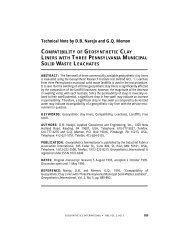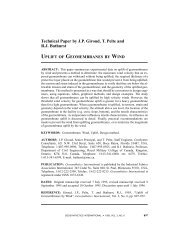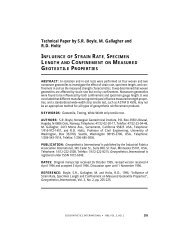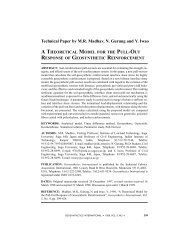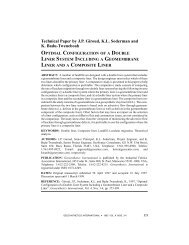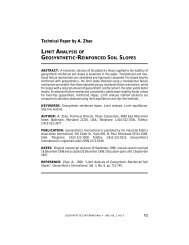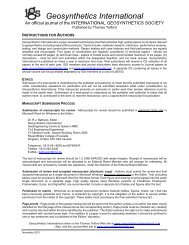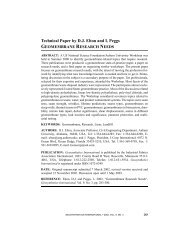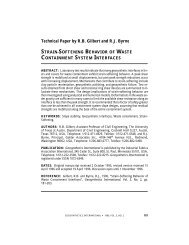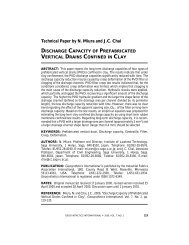Technical Paper by A. Fakher and C.J.F.P. Jones WHEN THE ...
Technical Paper by A. Fakher and C.J.F.P. Jones WHEN THE ...
Technical Paper by A. Fakher and C.J.F.P. Jones WHEN THE ...
Create successful ePaper yourself
Turn your PDF publications into a flip-book with our unique Google optimized e-Paper software.
FAKHER & JONES • When Bending Stiffness of Geosynthetic Reinforcement is Important<br />
0.15<br />
0.10<br />
0.05<br />
Figure 13.<br />
Yd / B<br />
0.00<br />
-0.05<br />
-0.10<br />
f-20, no-reinf., s/B = 0.3<br />
-0.15<br />
f-20, beam, s/B = 0.3<br />
-0.20<br />
-0.25<br />
f-20, cable, s/B = 0.2<br />
-0.30<br />
0 2 4 6 8 10<br />
X / B<br />
The deformed shape of the ground surface.<br />
layer. When the bending stiffness of the reinforcement is high, the heave is reduced<br />
<strong>and</strong> distributed over a wider area. It can be concluded that the use of geosynthetic reinforcement<br />
having a stiff three-dimensional structure, such as a geocell, is beneficial.<br />
The structural behaviour of the geosynthetic in this situation can be likened to a<br />
plate that has bending stiffness (flexural rigidity) <strong>and</strong> tensile stiffness. The plate-type<br />
behaviour of reinforcement, with bending stiffness, overlaying super soft clay provides<br />
more than a large displacement mechanism, such as a membrane-type support<br />
system (Burd 1995). The plate-type behaviour starts with a small vertical deflection of<br />
the reinforcement <strong>and</strong> distributes the heave of the ground surface over a wider area as<br />
the vertical deflection of the footing increases. It is seen that as the size of the footing<br />
increases, the influence of the bending stiffness of the reinforcement decreases<br />
sharply; this confirms the plate-type behaviour of the mechanism.<br />
When a fill is being spread on the geosynthetic overlying the super soft clay, the<br />
surface layer of the clay tends to move laterally, pushed out <strong>by</strong> the spreading layers of<br />
soil. Consequently, a tensile force is developed in the geosynthetic reinforcement due<br />
to lateral movement of the soil. This tensile force needs to be sustained <strong>by</strong> the anchorage<br />
of the reinforcement; this is provided <strong>by</strong> the pull out resistance of the reinforcement<br />
at the interface of the s<strong>and</strong> <strong>and</strong> clay. As the reinforcement tensile stiffness<br />
increases, the required pull out displacement to mobilise the maximum pull out resistance<br />
decreases. Hence, a geosynthetic reinforcement with a high tensile stiffness (as<br />
opposed to high bending stiffness) provides a better anchorage in the soils resulting in<br />
an increase in the bearing capacity.<br />
4 CONCLUSIONS<br />
The bending stiffness of geosynthetic reinforcement is neglected in most design prac-<br />
GEOSYN<strong>THE</strong>TICS INTERNATIONAL • 2001, VOL. 8, NO. 5 457



